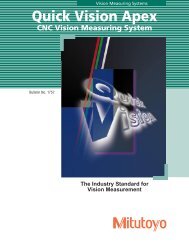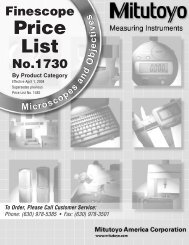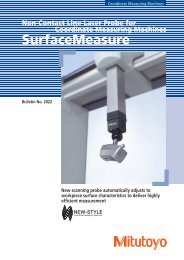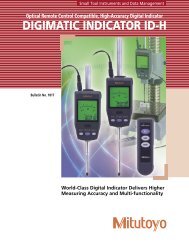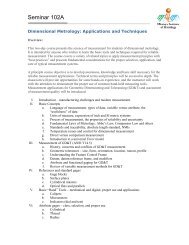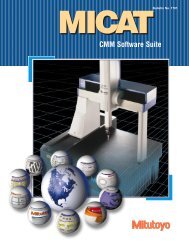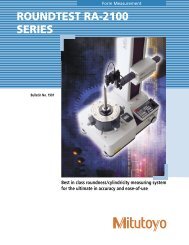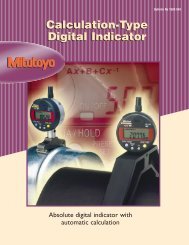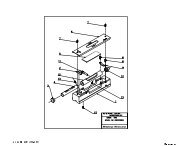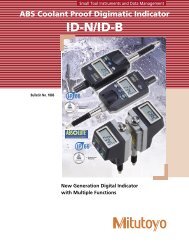SURFPAK® SJ/SV/PRO - Mitutoyo America Corporation
SURFPAK® SJ/SV/PRO - Mitutoyo America Corporation
SURFPAK® SJ/SV/PRO - Mitutoyo America Corporation
- No tags were found...
You also want an ePaper? Increase the reach of your titles
YUMPU automatically turns print PDFs into web optimized ePapers that Google loves.
Surface-, Form-, and Contour MeasurementSURFPAK ® <strong>SJ</strong>/<strong>SV</strong>/<strong>PRO</strong>Bulletin No. 1685Surface TextureAnalysis Software
Easy operation with mouse• The arrangement of machine control icons differ dependingupon the Surftest measuring unit to be used with.Machine operationicons for the<strong>SV</strong>-Series SurftestWindow in measuring…SURFPAK ® -<strong>SV</strong>Machine operationicons for the<strong>SJ</strong>-201/301/401SurftestSURFPAK ® -<strong>SJ</strong>Conforming to the World’s Standards• Conforming to the world surface roughness standards includingDIN, ISO, JIS, Motif, etc.• Combinations of a variety of evaluation profiles and parameterssatisfy various needs for surface roughness evaluations.Measuring conditions setting window(SURFPAK ® -<strong>SV</strong>)Measuring conditions setting window(SURFPAK ® -<strong>SJ</strong>)3
SURFPAK ® - <strong>SJ</strong>, SURFPAK ® - <strong>SV</strong>Surface texture-analyzing programVarious Types of Analysis Graphs• Provides various types of analysis graphs, such as BAC(material ratio curve),ADC (profile height amplitude curve),power spectrum chart, etc. for diverse evaluations ofsurface textures.• The graph profiles help visual assessment of the surfacetexture of workpiece.Easy Calibration Operation• Calibration can be easily performed by measuring a referenceroughness specimen the reference value of which was enteredwith the ten-key.ADC (profileheight amplitudecurve) and BAC(material ratiocurve)CalibrationwindowsAuto-correlationchartStraightness CompensationFunction• Improves the mechanical straightness of the X-axis drive unit.• Eliminates straightness error from the measured data, basedon the drive unit error data obtained from the measurementof a master plane such as an optical flat.Enlarged display ofmeasured profileRecalculation Function• Once the measured data is stored in the hard disk, theoperator is able to perform recalculation on the measureddata by changing evaluation range, cutoff length, etc. oradding evaluation parameters and analysis graphs asrequired.• Measurement conditions once set can be easily retrieved.Unnecessary Data Deletion• Deletes unnecessary data points, then recalculates the dataor resets the evaluation length and the evaluation range.• Automatically deletes unnecessary data points whenconditions are set at the time of measurement. (Theworkpiece surface, as shown below, can be automaticallyevaluated with the groove excluded, for example.)EvaluatingconditionssettingwindowsEffective rangeDelete Delete Delete4
Data Compensation Function• Tilt compensation: Compensates tilt in the measureddata. In addition to the compensation of the entire data,the compensation of a desired area is also possible.• R-plane compensation: Compensates the measured datato eliminate curvature in the measurement of the surfacetexture of R (curved surface such as cylinder or sphere),processing the data as those of a flat surface.• Equipped with polynomial automatic compensation functionfor the elimination of irregular surface texture elements, etc.Report Generation Function• The assessed profiles, calculation results, measuringconditions, and comments can be freely laid out and printedout as reports.• Cut and paste-up not only themeasurement data but alsofiles (bit map) to create uniquereports with photos logos.• Create one layout and use it alsofor other measurements.• Reports can be printed on largesize paper or in color using theoptional color printer.imagePrintoutexamplesData communication withSurftest <strong>SJ</strong>-201/301/401• The assessed profiles, calculation results, measuring conditions,and comments can be freely laid out and printed out as reports.• Cut and paste-up not only the measurement data but alsoimage files (bit map) to create unique reports with photosand company logos.<strong>SJ</strong>-201RS-232C connecting cable (2m)Bit-map imagepaste-up functionLayout editwindow<strong>SJ</strong>-301/401RS-232C connecting cable (2m)MemorcardCOMPACTFLASH TMCard ReaderSURFPAK ® -<strong>SJ</strong>RS-232C Connecting Cables• The RS-232C Connecting Cables connect the Surftest<strong>SJ</strong>-201, <strong>SJ</strong>-301, or <strong>SJ</strong>-401 with the external PC.• Compatible with the RS-232C Interface.• By using the software, SURFPAK ® -<strong>SJ</strong>, measurement resultsand measuring conditions can be output to the PC. It alsoallows the operator to operate the Surftest from the PC.Memory Card• For storing the evaluation, sampling, and statistical analysisresult data acquired with the Surftest <strong>SJ</strong>-301 and <strong>SJ</strong>-401.• Can store the maximum of 20 measuring conditions.• The optional card reader allows the data collected at themeasurement site with the <strong>SJ</strong>-301 or <strong>SJ</strong>-401 to be broughtinto the laboratory, etc. where the data can be analyzedusing SURFPAK ® -<strong>SJ</strong>.12AAA20812AAA88212AAA841Order No. 12AAA208 12AAA882 12AAA841Applicable Surftest <strong>SJ</strong>-201 <strong>SJ</strong>-301, <strong>SJ</strong>-401 –Connector type D-SUB (9-pin) –Cable length 6.56 feet (2 meters) –Data storage media – – COMPACTFLASHData capacity – – 8MB5
SURFPAK ® - <strong>SJ</strong>, SURFPAK ® - <strong>SV</strong>Surface texture-analyzing programSURFPAK ® -<strong>SJ</strong> and SURFPAK ® -<strong>SV</strong> SpecificationsIndustrial standards to be conformedAssessed profilesISO 4287:1997, ANSI/ASME B46.1-1995, JIS B0601 1994, JIS B0601 2001 etc.P (primary profile), R (roughness profile), WC, WCA, WE, WEA, DIN4776 profile,E (envelope residual profile), R-motif (roughness motif), W-motif (waviness motif)Evaluation P, R, WC, WCA, WE, Ra, Rq, Rz, Rz(JIS), Ry, Ry(DIN), Rc, Rpi, Rp, Rpmax, Rvi, Rv, Rvmax, Rti, Rt, R3zi, R3z, R3y, S, Pc (Ppi),parameters WEA, DIN4776, E Sm, HSC, mr, δc, plateau ratio, mrd, Rk, Rpk, Rvk, Mr1, Mr2, ∆a, ∆q, λa, λq, Sk, Ku, Lo, Lr, A1, A2Analysis graphsDigital filterCutoff length*R-motifW-motifSampling length (L)*Data compensationRx, R, AR, SR, SAR, NR, NCRX, CPMWte, Wx, W, AW, SW, SAW, NWADC, BAC1, BAC2, power spectrum chart, auto-correlation chart, Walsh power spectrum chart, Walshauto-correlation chart, slope distribution chart, local peak distribution chart, parameter distribution chart2CR-75%, 2CR-50%, 2CR-75% (phase corrected), 2CR-50% (phase corrected),Gaussian-50% (phase corrected)λc: .001" † , .003" † , .01", .03", .1", .3", 1" † or arbitrary value(0.025mm † , 0.08mm † , 0.25mm, 0.8mm, 2.5mm, 8mm, 25mm † or arbitrary value)fl: .003" † , .01", .03", .1", .3", 1" † or arbitrary value)(0.08mm † , 0.25mm, 0.8mm, 2.5mm, 8mm, 25mm † or arbitrary value)fh: .003" † , .01", .03", .1", .3" or arbitrary value(0.08mm † , 0.25mm, 0.8mm, 2.5mm, 8mm or arbitrary value).001" † , .003" † , .01", .03", .1", .3", 1" † or arbitrary value(0.025mm † , 0.08mm † , 0.25mm, 0.8mm, 2.5mm, 8mm, 25mm † or arbitrary value)Tilt compensation, R-plane (curved surface) compensation, ellipse compensation, parabolacompensation, hyperbola compensation, quadric curve automatic compensation, polynomialcompensation, polynomial automatic compensationData deletion function• Data deletion to avoid an over-range error• Data deletion in a specific range to perform recalculation• Automatic data deletion (according to a condition preset)Recording magnifications Vertical: 100X - 500,000XHorizontal: 1X - 10,000XSpecial functions for report generationOS requirement• Bit-map image paste-up function• Multiple data layout functionWindows ® NT 4.0 / Windows ® 2000 / Windows ® XP* Arbitrary value can be specified in the following range: SURFPAK ® -<strong>SJ</strong> — from .012" (0.3mm) to the maximum traverse length.SURFPAK ® -<strong>SV</strong> — from .001" (0.025mm) to the maximum traverse length.†Not available on SURFPAK ® -<strong>SJ</strong>6
SURFPAK ® - <strong>PRO</strong>Surface texture-analyzing program• SURFPAK ® -<strong>PRO</strong> provides a variety of graphics methods andevaluation parameters for various surface texture evaluationsfrom the three-dimensional topography data.• A desired topographic profile can be analyzed twodimensionally,thus allowing the evaluation of fine contourand fine texture at the same time.• SURFPAK ® -<strong>PRO</strong> is the standard software package providedfor <strong>Mitutoyo</strong> Surftest <strong>SV</strong>-3000•3D.Measurement result windows3-D topography(contour lines) display3-D topography display Cross-section analysis display8Peak height distribution chartProbability distribution chartBAC (material ratio curve) andADC (profile height amplitude curve)
Can be used with 3-D Auto-leveling TableThe 3-D auto-leveling table, which is a standard accessory for <strong>Mitutoyo</strong>Surftest <strong>SV</strong>-3000•3D, adjusts the level of the measuring surface ofthe workpiece automatically.Leveling is completeLeveling is not completeThis relieves the operator fromthe time-consuming manualadjustment that a conventionaltype machine would require, thusgreatly improving work efficiency.SURFPAK ® -<strong>PRO</strong> SpecificationsIndustrial standards to be conformedAssessed profilesISO 4287:1997, ANSI/ASME B46.1-1995, JIS B0601 1994, JIS B0601 2001 etc.P (primary profile), R (roughness profile), WC, WCA, WE, WEA, DIN4776 profile,E (envelope residual profile), R-motif (roughness motif), W-motif (waviness motif)Two-dimensional P, R, WC, WCA, WE, Ra, Rq, Rz, Rz(JIS), Ry, Ry(DIN), Rc, Rpi, Rp, Rpmax, Rvi, Rv, Rvmax, Rti, Rt, R3zi, R3z, R3y, S, Pc (Ppi),evaluation WEA, DIN4776, E Sm, HSC, mr, δc, plateau ratio, mrd, Rk, Rpk, Rvk, Mr1, Mr2, ∆a, ∆q, λa, λq, Sk, Ku, Lo, Lr, A1, A2parametersR-motifRx, R, AR, SR, SAR, NR, NCRX, CPMW-motifThree-dimensional evaluation parameters(Can be obtained from a dense group ofassessed profiles — primary profiles,roughness profiles, or waviness profiles)Wte, Wx, W, AW, SW, SAW, NWSa (arithmetic mean deviation), Sq (root-mean-square deviation), Sz (ten-point height of irregularities),Sp (maximum profile height), Sv (maximum profile valley depth), St (total height), S3y (third maximumpeak-to-valley height), Spc (peak count), Svc (valley count), Spd (peak density), Svd (valley density),Ssk (skewness), Sku (kurtosis), S∆q (root-mean-square slope), Sλ (root-mean-square wavelength),So (developed area), Sr (developed area ratio)Topographic profile sampling function A desired cross-section which is included in a three-dimensional topography data can be analyzedtwo-dimensionally.Analysis graphs Two-dimensional ADC, BAC1, BAC2, power spectrum chart, auto-correlation chart, Walsh power spectrum chart, Walshauto-correlation chart, slope distribution chart, local peak distribution chart, parameter distribution chartThree-dimensional 3-D topography display, 3-D topography (contour line) display, topographic profile (cross-section)analysis, ADC, BAC1, BAC2, power spectrum chart, probability distribution chart, local peak distributionchart, parameter distribution chart, slope enhancementDigital filter Two-dimensional 2CR-75%, 2CR-50%, 2CR-75% (phase corrected), 2CR-50% (phase corrected), Gaussian-50%Cutoff length*Sampling length (L)*Data compensation(Two-dimensional)Trend compensation(Three-dimensional)Data deletion functionThree-dimensionalMoving average filter, Gaussian filterλc: .001", .003", .01", .03", .1", .3", 1" or arbitrary value(0.025mm, 0.08mm, 0.25mm, 0.8mm, 2.5mm, 8mm, 25mm or arbitrary value)fl: .003", .01", .03", .1", .3", 1" or arbitrary value)(0.08mm, 0.25mm, 0.8mm, 2.5mm, 8mm, 25mm or arbitrary value)fh: .003", .01", .03", .1", .3" or arbitrary value(0.08mm, 0.25mm, 0.8mm, 2.5mm, 8mm or arbitrary value).001", .003", .01", .03", .1", .3", 1" or arbitrary value(0.025mm, 0.08mm, 0.25mm, 0.8mm, 2.5mm, 8mm, 25mm or arbitrary value)Tilt compensation, R-plane (curved surface) compensation, ellipse compensation, parabolacompensation, hyperbola compensation, quadric curve automatic compensation, polynomialcompensation, polynomial automatic compensationPlane compensation, sphere compensation, cylinder compensation, polyhedron compensation• Data deletion to avoid an over-range error • Data deletion in a specific range to perform recalculation• Automatic data deletion (according to a condition preset)Recording magnifications Vertical: 100X - 500,000X Horizontal: 1X - 10,000XSpecial functions for report generation • Bit-map image paste-up function • Multiple data layout functionOS requirementWindows ® NT 4.0 / Windows ® 2000 / Windows ® XP*Arbitrary value can be specified in the range from .001" (0.025mm) to the maximum traverse length.9
FORMPAK ® - <strong>SV</strong>Fine contour analyzing software for Surftest• Evaluates the fine texture of the workpiece surfacethat cannot be evaluated in the surface roughnessparameters.• In addition to dimensional measurement capabilities(angles, radii, and distances measurement), thecontour tolerancing function for evaluating “form”.• Performs various analysis/evaluations including thecontour evaluation of step and pitch and thecalculation of areas.Data display windowCommand iconsOperationguidewindowOperation procedure windowMeasurement result window10Various Contour Evaluation Commands• By combining contour elements such as point, line, circle,and coordinates, various evaluations can be performed,including the length measurement of step and pitch, thearea calculation, etc.Data Processing Function• Allows assessed profile filtration, deletion of data, datacut-off, and combination of data from multiple measurements.Data Compensation Function• Circular error compensation function: Compensates circularmovementerror of the stylus to reduce distortion, thusobtaining the data that is closest to the actual contour data.• Stylus-tip diameter compensation: Offsets the measured datafor the stylus-tip diameter.Report Generation Function• Just like the SURFPAK ® series software, FORMPAK ® -<strong>SV</strong>allows measurement results to be freely laid out and printedout as report.This program also supports the optionalcolor printer.
Contour tolerancing function• This function compares measured form data with nominaldata, displays the deviation, and then stores it. Form data isdifferent from dimensional measurement of angle, radius, etc.In addition to values obtained from an ideal contour in aCAD drawing, nominal values can also be created byconverting the measured data of a master.External output function• Calculation results and tolerancing results can be output in areadable format to commercial spreadsheet software.Thisfunction increases processing capabilities including statisticalcalculation, saving, and management of measurement results.It also allows measured point group data to be output ina text format.Icon editing function• Measurement icons can be rearranged or replaced asdesired. It is also possible to enlarge the icons for greatervisibility.MeasureddataTolerancingBest-fitprocessingTolerancingcalculationTolerancingresults displayContourtolerancing flowNominaldata• Created by the function• Converted from themaster measured data• Input from CADFORMPAK ® -<strong>SV</strong> SpecificationsCompatibleSURFPAK ® SURFPAK ® -<strong>SV</strong>, SURFPAK ® -<strong>PRO</strong>SeriesOperation Point measurement: Point, peak, contact, intersection,commands bisector-point (between elements/between piecesof measured data)Line measurement: Line, tangent line, perpendicular,parallel line, bisectorCircle measurement: Circle (multi-point/range/centerand radius), contact circlePosition/difference: Coordinate difference, trueposition judgmentDistance/angle: Distance, groove width, step pitch,angle, reference setting (point/line/circle)Coordinate system setting: Origin setting, coordinatesystem rotationCalculation/statistics: Arithmetic calculation, absolutevalue, square root, maximum value, minimum value,mean, sum, standard deviation, unbiased standarddeviation, area, automatic circle/line definitionEditing of measured points: Data deletion,translation, rotation, mirror image, positioning,combination, separation, projection, offsetting,idealizingContour • Nominal data creation: Function specification (line/tolerancing circle/aspheric surface, etc.), CAD data input (IGES/DXF), measured data conversion, text file conversion• Tolerancing direction setting: Normal direction,X-axis direction, Z-axis direction• Reference coordinate system translation/rotation• Best-fit: X-axis translation, Z-axis translation,rotation, combination of several motions• Nominal data tolerancing• Result display: Lists, graphicsSpecial (i) Sub-part program: Calculation procedure can befunctions registered as a sub-part program. The sub-partprogram can be integrated into a part program,facilitating measurement of a batch of workpieces.(ii) Measured data/condition saving: Measured dataand analysis procedure can be saved in thehard disk.(iii) Report creation function: Recorded profiles,measurement results and measurement conditionscan be arranged in a form and laid out as desired.This function allows an original result report to becreated and printed out.(iv) External output of data: Analysis results (numericalvalues) can be output in the C<strong>SV</strong> format, andtherefore, can be easily accessed by spreadsheetsoftware on the market. Also, measured data(multi-point data) can be output in the ASCII code.(v) Part program creation: Measurement procedurescomplete with measurement, analysis, contourtolerance judgment, print, and save as a file, canbe registered as a part program. The part programcan be used for automatic measurements.(vi) Polar coordinate development display: Developsa circular form on to the polar coordinate system,where the range for circle calculation can bespecified.OS Windows ® NT4.0 / Windows ® 2000 / Windows ® XPrequirementDeveloped errordisplay windowTolerancing resultwindow11
Surftest TerminologyP: Primary profileThe primary profile is a profile obtainedby intersecting a surface with a planenormal to the nominal surface. It is arepresentation of the real profile(a profile of the real surface) obtainedby a Surftest.R: Roughness profileThe roughness profile is an assessedprofile which is obtained from theprimary profile by filtering longer waves(waviness components) as specified bycutoff length λc.W: Filtered waviness profileThe filtered waviness profile is a profileresulting from a primary profile that hasits shorter wavelength components andlonger wavelength components removedthrough filtering.WCA: Filtered center linewaviness profileThe filtered center line waviness profileis an assessed profile which is obtainedfrom the primary profile by filteringlonger waves (waviness components),as specified by fl, and shorter waves(roughness components), as specified byf h, while passing mid-range waves.WEA: Rolling circle center linewaviness profileA rolling circle center line wavinessprofile is the profile that results from arolling circle waviness profile that has itslonger wavelength components (called“waviness components”) filtered out.E: Envelope residual profileAn envelope residual profile is a profileof the residual (deviation) of a calculatedrolling circle waviness profile from theprimary profile.Rolling circleLocus of the rolling circlen elo eresi u lDIN4776 profileFor surfaces to be measured having deepvalleys with respect to the irregularityon the surface, the position of the meanline may be calculated to the positionshifted from the position where it issupposed to be for surface roughnessevaluation. However, by using theDIN4776 profile calculating procedure,those negative effects can be avoided toa certain extent.Cutoff filterCutoff filter rejects data in a particularrange (or ranges) of wavelengths fromthe primary profile.Damping characteristics of cutoff filter(Gaussian-50% type)λc= 0.25 λc= 2.5λc= 0.08 λc= 0.8 λc= 8100Unit: mmCutoff lengthThe cutoff length is a sampling length(e.g. wavelength: λ) to be used to filterthe primary profile.The cutoff length toreject long wavelength (or low frequency)data to obtain the roughness profile isknown as λc; the cutoff length to rejectshort wavelength (or high frequency)data to obtain the waviness profile isknown as f h; and the cutoff lengthused together with f h to reject longwavelength (or low frequency) data toobtain the filtered center line wavinessprofile is f l.Effect of data filteringDifferent roughness profiles will beobtained from the same primary profileaccording to the different cutoff lengthsof the filter.2.5µmLongwavelengthWavinesscomponentWavinessprofilePrimary profile1mmλc= 0.8mm Ra: 3.5 to 4.2µmλc= 0.25mm Ra: 1.8 to 2.2µmλc= 0.08mm Ra: 0.95 to 1.05µmRoughnessprofileRoughnesscomponentma oShortwavelengthProfile peak and profile valleyWhen a profile is sliced by its mean line,the portion that projects upward fromthe mean line is called the “profile peak”,and that which projects downward iscalled the “profile valley”.Peak Highest peak Mean lineRo oWE: Rolling circle waviness profileA rolling circle waviness profile is thelocus of points formed by the centerof a circle with a given radius that rollsover the workpiece surface (whileremoving roughness components).This circle is called the rolling circle.m lit e t an mi i ilit ( )50100.025 0.08 0.25 0.8 2.5 8 25Wavelength (mm)Deepest valleySampling length LLocal peak Mean lineLocal valleyValley12
Surftest TerminologySampling length (L)The sampling length is the minimumevaluation length used to obtain anevaluation value from an assessedprofile, according to the selected parameter.Thesampling lengths of roughnessand waviness profiles are identical tocutoff length λc and fh, respectively.The sampling length of WCA correspondsto fl.Pre-travelL: Sampling lengthln: val ation lengthlt: raverse lengthTraverse length (lt)The traverse length equals the sum ofthe evaluation length, pre-travel length,and post-travel length.Marginal length (pre-travel andpost-travel)In addition to the start-up travel of theSurftest detector itself, a pre-travel andpost-travel are also required for datafiltering.ean linePost-travelEvaluation length (ln)The evaluation length is the sum of n(successive integers) pieces of samplinglengths. (Usually an evaluation lengthcomprises five sampling lengths.)In general evaluation of surface texture,all of the data logged in each samplinglength is averaged throughout theevaluation length, yielding the evaluationvalue (such as Ra, Rq, Ry, Pc, Sm, HSC,and S). However, depending on theparameters, the evaluation value mayuse the maximum value in the entireevaluation length (e.g. Ry(DIN), Rp, Rv,and Rt).Mean lineThe mean line is a reference line forparameter calculation. It uses the filteredwaviness profile of an assessed profile,which is determined by eliminatingsurface roughness components shorterthan the specified wavelength from theprimary profile using a high-pass filter.Ra: Arithmetic mean deviation ofthe profileRa is the arithmetic mean of the absolutevalues of the profile deviation Yi from themean line. Ra(ANSI) is defined over theentire evaluation length.Rq: Root-mean-square deviation ofthe profileRq is the square root of the arithmeticmean of the squares of profile deviationsYi from the mean line. Rq(ANSI) isdefined over the entire evaluation length.Rz(JIS):Ten-point height ofirregularitiesRz(JIS) is the sum of the mean heightof the five highest profile peaks and themean depth of the five deepest profilevalleys measured from a line parallel tothe mean line.LLRoughness analysis parametersRy(JIS): Maximum height ofthe profileRy(JIS) is the sum of height Yp of thehighest peak from the mean line anddepth Yv of the deepest valley from themean line.LRc: Mean peak-to-valley height ofthe profileRc is the distance between the averageof all peak heights from the mean lineand the average of all valley depths fromthe mean line.LRz: Maximum height of the profileRy(DIN): Maximum height of theprofileObtain the sum Zi of profile peak heightPi and profile valley depth Vi for eachsampling length. Rz is the mean valueof all Zi’s over the evaluation length.Ry(DIN) is the maximum value of allZi’s over the evaluation length.Rp, Rpmax: Maximum profile heightObtain the profile peak height Rpi foreach sampling length of the assessedprofile. Rp is the mean value of the Rpi’sobtained over the evaluation length.Rp(ANSI) (=Rpmax) is the maximumvalue of the Rpi’s obtained over theevaluation length.lniVii13
Surftest TerminologyRv, Rvmax: Maximum profilevalley depthObtain the profile valley depth Rvi foreach sampling length of the assessedprofile. Rv is the mean of the Rvi’sobtained over the evaluation length.Rv(ANSI) (=Rvmax) is the maximumvalue of the Rvi’s obtained over theevaluation length.Rt:Total height of the profileRt is the sum of the maximum profilepeak height Rpmax and the maximumprofile valley depth Rvmax obtainedover the evaluation length.R3z, R3y:Third maximum peak-tovalleyheightObtain, for each sampling length, thesum (3zi) of the height of the thirdhighest profile peak above the mean lineand the depth (absolute value) of thethird deepest profile valley below themean line. R3z is the arithmetic mean ofthe all 3zi’s obtained over the evaluationlength. R3y is the maximum value of the3zi’s obtained over the evaluation length.3ziRviHSC: High spot countOn the assessed profile provided a line(called a “count level”) which is parallelto and located above the mean line.A profile peak that projects above thecount level line and has a local peak*is called a “peak for high spot count”.HSC (high spot count) is the numberof these peaks per 1cm or 1 inch.*A local peak is the highest point of a convex portion ofan assessed profile, which has concavities on both sides.The distance between adjacent concavities should bemore than 1% of L, or the depth of the concavities shouldbe more than 10% of Rz.LS: Mean spacing of local peaksof profileS is the arithmetic mean of peak-to-peakdistances of the local peaks.S1 S S S S Smr, mrd: Material ratio of the profileδc (plateau ratio): Profile sectionheight differenceThe material ratio of the profile is theratio of the bearing length to the evaluationlength. It is represented as a percentage(%).The bearing length is the sum ofsection lengths obtained by cutting theprofile with a line (slice level) drawnparallel to the mean line at a given level.The ratio is assumed to be 0% if theslice level is at the highest peak, and100% if it is at the deepest valley.Parameter mr determines the percentageof each bearing length ratio of a single slicelevel or 19 slice levels which are drawn atequal intervals (5%) with Rt; parameterδc (or plateau ratio) determines thedistance (µm or µinch) between thetwo slice levels which are representedby two different mr values (%); andparameter mrd determines the mrvalue (%) of a slice level each time it ismoved down at equal intervals from agiven level in the profile.BAC1, BAC2: Material ratio curveof the profileThe material ratio curve is the graphobtained by plotting mr values (%) of theassessed profile on the X coordinateagainst their corresponding slice leveldepths or heights on the Y coordinate.BAC1 is the graph that shows therelative depths of the slice level (100%down to 0% of Rt) on the Y coordinate;BAC2 is the one that shows the actualheights (µm or µinch) on the Y coordinate.LLLLµµµµµµµµµPc (Pci): Peak countPc (or Pci) is the number of peak-valleypairs (= cycles) per unit length 1cm (or1 inch) along the mean line of the profilewithin the sampling length.Two lines(count levels) that are parallel to themean line are drawn at equal distancesabove and below the mean line. Eachprofile cycle between intersections ofthe profile and the mean line, betweenwhich a peak projects above the uppercount level and an adjacent valley dropsbelow the lower count level, is countedas one peak-valley cycle.Sm: Mean width of the profileelementsSm is equal to the mean wavelength ofthe peak-valley cycles. It is the reciprocalof the Pc (peak count) valueRk: Core roughness depthAssume that a straight line (function)passes through two points that pinpointthe 40% difference in mr and the minimumdifference in height on the BAC2graph.The core roughness depth Rk isthe difference between the heights ofthe slice level at 0% of mr and at 100%of mr on this straight line.(µ )RpkRkRvk0(%)A1Mr1ARpk: Reduced peak heightRvk: Reduced valley heightA1: Peak areaA2:Valley areaMr1: Material portion 1Mr2: Material portion 2These parameters, along with Rk, areobtained from the BAC2 graph.L40%LBA2Mr2 100(%)14
Surftest TerminologyADC: Profile height amplitudecurveAssume that the assessed profile isdivided by lines parallel to the mean lineat constant intervals and the ratio of eacharea (which is determined by summingthe sampling dots) between two adjacentlines to the area over the evaluationlength is defined as the amplitudedensity.The ADC (profile heightamplitude curve) is created by plottingthe level (µm) of each of the parallellines on the Y coordinate and theamplitude density (%) correspondingto the depth on the X coordinate.LSk: Skewness of the profileSk is the degree of bias of an amplitudedistribution curve either above or belowthe mean line.ean lineAssessed profileKu: KurtosisKu is the degree of concentrationaround the mean value of an amplitudedistribution curve.Assessed profileL µADCADCSk=0Sk0(Abrasionresistance: small)Ku is largeKu is small∆a:Arithmetic mean slope ofthe profile∆a is the arithmetic mean of theabsolute values of the local slope(δz/δx) of the assessed profile.∆q: Root-mean-square slope ofthe profile∆q is the square root of arithmeticmean of the squares of the local slope(δz/δx) of the assessed profile.λa:Average wavelength ofthe profileλa is an average wavelength that can becalculated from Ra (µm or µinch) and∆a (degree) using the following formula.λa = 2π•Ra/∆aλq: Root-mean-square wavelengthλq is a mean wavelength that can becalculated from Rq (µm or µinch) and∆q (degree) using the following formula.λq = 2π•Rq/∆qLo: Developed profile lengthlr: Profile length ratioLo is the length of a straight line whichis obtained by developing an assessedprofile. lr is the ratio of a developedprofile length Lo to the sampling length.It represents the degree of profileirregularities.MotifMotifs are used to evaluate an assessedprofile which is compensated accordingto a French standard to removearbitrary waviness components froma primary profile without distorting it.Two motif modes are available: roughnessmotif and waviness motif.Waviness motifo ness motifRx, R,AR, SR, SAR, NR, NCRX, CPMParameters calculated from a roughnessmotif. Rx is the maximum value ofroughness motif heights. R is the meanof roughness motif heights. AR is themean of roughness motif widths. SR isthe standard deviation of roughnessmotif heights. SAR is the standard deviationof roughness motif widths. NR isthe number of roughness motifs. NCRXis the number of vertexes of concavitiesextracted before the composition ofroughness motifs. CPM is the averagenumber of valleys per roughness motif.Wte,Wx,W,AW, SW, SAW, NWParameters calculated from a wavinessmotif. Wte is the difference betweenthe maximum height and the minimumheight of the profile. Wx is the maximumvalue of waviness motif heights.W is themean of waviness motif heights. AW isthe mean of waviness motif widths. SWis the standard deviation of wavinessmotif heights. SAW is the standarddeviation of waviness motif widths. NWis the number of waviness motifs.Auto-correlation chartThe auto-correlation function representsthe degree of consistency between twopoints apart from a definite distance onthe entire profile. If a height (depth)appears again in a definite distance, thevalue of the correlation function will be 1.Generally, the correlation function will takea large value at a periodic interval, whichis equal to the wavelength of the primarycomponent of the profile.Therefore, theprimary wave component of the profilecan be seen from the variation of theauto-correlation function values.Power spectrum chartAssuming that the profile is a sum ofwave components with different wavelengths,it can be characterized by thedistribution pattern of the wavelengths.A power spectrum chart is createdplotting the wavelength (mm) or spatialfrequency (c/mm) on the X coordinateand the intensity (amplitude) on theY coordinate to display the distributionof wave components.A power spectrumand an auto-correlation share the sameinformation in the spatial field andthe wavelength field, respectively.In other words, they represent thesame information in different formats.Slope distribution chartDivide the profile into sections at aconstant width and obtain the angle ofinclination of a line that connects thestart point and the end point of theprofile in each section.A slope distributionchart is created by plotting the angles onthe X coordinate and the ratio (%) ofslope distributions on the Y coordinate.Local peak distribution chartAssume that the assessed profile is dividedby lines parallel to the mean line atconstant intervals and count the numberlocal peaks at each slice level. A localpeak distribution chart is created byplotting the number of local peaks per1mm on the X coordinate and thedepths of the slice level (100% down to0% of Rt) on the Y coordinate.Parameter distribution chartTo obtain the continuous distribution ofa roughness parameter, set an evaluatingspan with a definite length, shorter thanthe evaluation length of the profile, andshift it at a predetermined length alongthe sampling direction in order to calculatethe parameter value at each position.A parameter distribution chart is createdby plotting the distance in the shift directionon the X coordinate and the parametervalues on the Y coordinate. One of thefollowing 22 parameters can be specifiedat a time: Ra, Rq, Ry, Rz, Rc, S, Pc, Sm,HSC, ∆a, ∆q, λa, λq, Sk, Ku, Lo, lr, Rpmax,Rvmax, Rt, R3y, R3z.15
Coordinate Measuring MachinesVision Measuring SystemsSurface Roughness, Form andContour MeasurementDigital Scale and DRO SystemsOptical Measuring MachinesSensor SystemsHardness Measuring MachinesSmall Tool Instruments andData ManagementJSAQ-052ISO 9001Made to Measure<strong>Mitutoyo</strong> <strong>America</strong> <strong>Corporation</strong>Regional Offices: Michigan (734) 459-2810 Illinois (630) 978-5385 California (626) 961-9661Massachusetts (978) 692-8765 Indiana (317) 577-6070 No. Carolina (704) 875-8332www.mitutoyo.com© 2003 <strong>Mitutoyo</strong> <strong>America</strong> <strong>Corporation</strong>, Aurora IL We reserve the right to change specifications and prices without notice. 7B-7 • Printed in USA • August 2003



